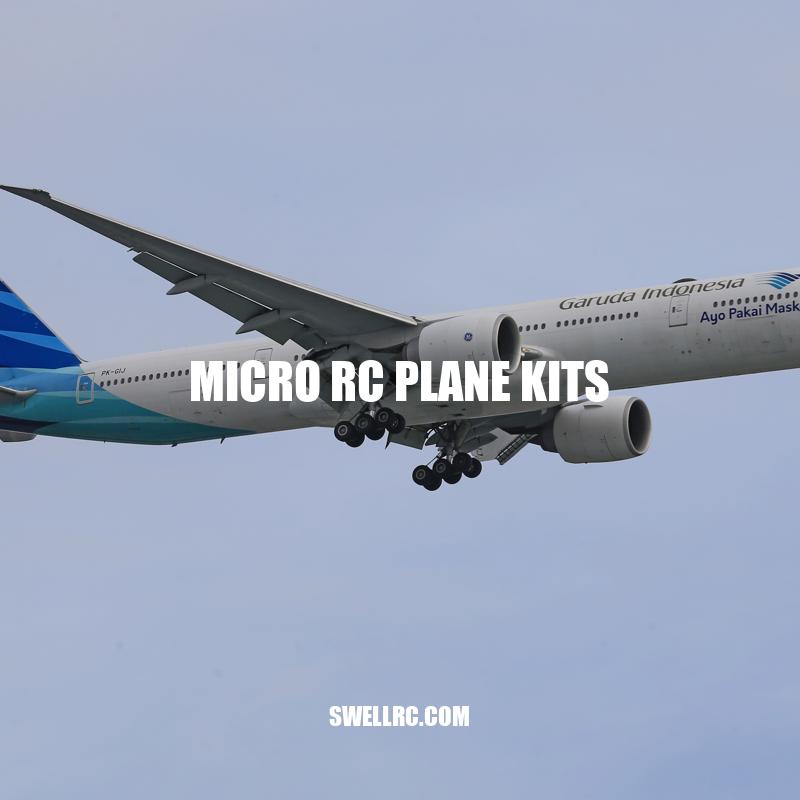Exploring the World of Micro RC Plane Kits: Building and Flying Tips
Micro RC Plane Kits: An Exciting and Accessible Hobby
Flying remote control planes has been a favorite pastime for many years, but with the latest advancements in technology and miniaturization, it’s now possible to enjoy the hobby indoors with micro rc plane kits. These kits are small but mighty, allowing for hours of entertainment without ever leaving the comfort of your home. What’s more, these planes are incredibly versatile, meaning they can be flown in a variety of settings, including tight indoor areas, dorm rooms, and outdoor spaces. This popularity has exploded in recent years due to the ease of use, affordable cost, and improved performance in the latest technology advancements. If you’re interested in giving this hobby a try, there are a few things you should know before jumping in. From the types of micro rc plane kits available to building and flying tips, this guide will give you a complete overview of this exciting and accessible hobby.
Types of Micro RC Plane Kits
Micro RC plane kits come in several types, each with unique features and specifications. Whether you’re a beginner or an experienced pilot, there’s a micro RC plane kit that suits your needs. Here are the main types of micro rc plane kits available:
- Ready-to-Fly (RTF) Kits: As the name suggests, these kits come with everything you need to fly the plane. RTF kits are perfect for beginners who want to get started right away without building or configuring anything. Examples of RTF micro rc plane kits include the E-flite UMX Radian, ParkZone Ultra Micro P-51D Mustang, and HobbyZone Champ S+.
- Almost Ready-to-Fly (ARF) Kits: ARF kits require more assembly than RTF kits and may need additional components. They are designed for more experienced pilots who want some flexibility in personalizing their planes to their preferences. Examples of ARF micro rc plane kits are the Extreme Fliers Micro Drone 3.0, Spektrum UMX PT-17, and Microaces Spitfire MkIX.
- Do-It-Yourself (DIY) Kits: For the ultimate micro rc plane customization, some enthusiasts prefer building their own planes from scratch using a DIY kit. These kits come with instructions and the necessary parts. DIY kits are perfect for those who have a lot of experience in building and configuring models. Examples of DIY kits include the Flite Test Micro Warthog, Volantex Ranger 2400, and Tattu Delta Wing FPV Wing.
If you’re new to micro RC planes, it’s best to start with an RTF micro rc plane kit to get the hang of it. As you gain more experience and confidence, you can move on to ARF or even DIY micro rc plane kits for greater customization.
There are several websites you can check out if you’re interested in learning more about micro rc plane kits, including the popular online retailer, Horizon Hobby. They offer a wide selection of micro rc plane kits along with other remote control models and accessories. Another great resource is Flite Test, which has a website and YouTube channel offering comprehensive tutorials, reviews, and advice on building, flying, and maintaining micro rc planes.
How many types of RC planes are there?
The most popular types for radio-controlled aircraft are internal combustion engines, electric motors, jet engines, and rocket engines. Three types of internal combustion engines are available being small 2 and 4 stroke engines.
Building Your Own Micro RC Plane Kit
Building your own micro rc plane kit may seem daunting at first, but it can be a very rewarding experience. Here are some tips on how to build your own micro rc plane kit:
- Select the Right Kit: Choose a kit that is appropriate for your skill level. If you’re new to building micro rc planes, start with a simple kit with easy-to-follow instructions. As you gain experience, you can move on to more complex kits.
- Get the Right Tools: Make sure you have all the necessary tools and equipment before starting. Some basic tools you’ll need include a soldering iron, pliers, wire cutters, and a hobby knife.
- Follow the Instructions: Take your time and carefully read the instructions. Make sure you understand each step before proceeding to the next one.
- Test and Tune: Once you’ve assembled your micro rc plane, it’s important to test and tune it before flying. Make any necessary adjustments to the controls and check that all the components are functioning properly.
Micro rc plane kits are not only fun to build but can also be a learning experience. Building your own kit can teach you about aerodynamics, electronics, and mechanics, among other things.
Before starting, you can check out online resources like RCGroups.com, which features forums where micro rc plane enthusiasts share tips, tricks, and advice on building and flying. There are also websites like Micro Motor Warehouse and Tiny Whoop that offer a wide selection of micro rc plane parts and upgrades.
| Website | Description |
|---|---|
| RCGroups | An online forum where micro rc plane enthusiasts can share tips and advice on building and flying. |
| Micro Motor Warehouse | A website that offers a wide variety of micro rc plane parts and upgrades. |
| Tiny Whoop | A website that specializes in offering various styles of micro fpv drones including kits and mods for different quadcopters. |
Is it hard to build an RC plane?
Building an RC plane requires a little planning and a few materials, but it is not necessarily hard. All you need are the main components of a plane, such as the body, wings, rudder, wheels, motor, and radio transmitter. With a few hours of work, you could become an expert at building RC airplanes. If you need any help or guidance, there are websites and products available to assist you in the process.
Flying Your Micro RC Plane Kit
Flying your micro rc plane kit can be a thrilling experience, but it is important to prioritize safety. Here are some tips on how to fly your micro rc plane kit safely:
- Select a Safe Flying Area: Make sure that you are flying in a safe and open area with no people or obstacles nearby. Avoid flying near power lines or airports.
- Check for Weather Conditions: Check the weather conditions before flying. Avoid flying in high winds, rain, or snow.
- Know Your Flight Time: Be aware of the battery life of your micro rc plane, and do not exceed the maximum recommended flight time.
- Practice Your Flying Skills: Begin by practicing simple maneuvers and gradually work your way to more complex ones. Practicing consistently can help improve your flying skills and confidence.
Knowing how to maneuver your micro rc plane is essential to ensure safe and enjoyable flights. There are various online resources and tools available that can help you learn the ins and outs of micro rc plane flying.
In addition to RCGroups.com, there are many websites and forums that cater to micro rc plane enthusiasts, such as Flite Test and RC Universe. These websites offer useful tips, tutorials, and reviews to help both beginners and experts improve their micro rc plane flying skills.
Furthermore, there are simulators such as RealFlight and Phoenix RC that can help you learn how to fly your micro rc plane without risking damage to your equipment. These simulators can provide a realistic flight experience, helping you learn to fly more efficiently while having fun.
Can I fly my RC plane anywhere?
In short, you cannot fly your RC plane anywhere. It is essential to find a large open space without endangering others or risking property damage and check local rules and regulations. Make sure to research thoroughly if flying an RC aircraft is permitted in your area, as laws and regulations can vary by location. Check out websites such as FAA’s “Know Before You Fly” for more information on flying drones or RC planes legally.
Conclusion
In conclusion, micro rc plane kits offer a fun and educational experience for anyone interested in remote control aircraft. With increasing popularity, there are many types of micro rc plane kits available on the market that cater to the needs and preferences of different hobbyists. Building and flying your own micro rc plane kit can also be a rewarding experience that teaches you valuable skills in engineering, handiwork, and problem-solving.
Micro rc plane kits are not just popular among hobbyists and enthusiasts, but they are also used for educational purposes and professional training. The use of micro rc planes in fields such as search and rescue, agriculture, and aerial photography is becoming increasingly important.
There’s no doubt that micro rc plane kits are here to stay and will continue to evolve with technological advancements, providing even more exciting opportunities for remote control enthusiasts. Whether you are an experienced pilot or a beginner, there is no doubt that the world of micro rc planes has something to offer for everyone.



